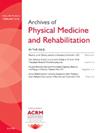Overground Robotic Exoskeleton Gait Training in People With Incomplete Spinal Cord Injury During Inpatient Rehabilitation: A Randomized Control Trial
IF 3.7
2区 医学
Q1 REHABILITATION
Archives of physical medicine and rehabilitation
Pub Date : 2025-09-01
DOI:10.1016/j.apmr.2025.04.015
引用次数: 0
Abstract
Objective
To examine the efficacy of a stakeholder-informed overground robotic exoskeleton (ORE) intervention to improve walking function after spinal cord injury (SCI) compared with usual care gait training.
Design
Randomized Controlled Trial.
Setting
Inpatient Rehabilitation Facility.
Participants
Patients (N=106; age, 51.5±18.5y; men, 78.3%; White, 65.1%) with subacute incomplete SCI.
Interventions
ORE compared with usual care gait training approaches including body-weight support treadmill training and traditional overground modalities.
Main Outcome Measures
Our primary outcome was walking performance defined by function [Walking Index for Spinal Cord Injury-Revised (WISCI-II)] and gait speed [10-m walk test (10MWT)]. Secondary outcomes were functional independence [Spinal Cord Independence Measure (SCIM) and CARE Tool] and patient-reported outcomes of pain, fatigue, spasticity, depression, anxiety, and quality of life.
Results
Patients were tetraplegia (56.6%) and ASIA Impairment Scale (AIS) B (17.9%), AIS C (28.3%), and AIS D (53.8%). Although improvement was observed in both the ORE and usual care groups across WISCI-II, 10MWT, and SCIM measures (all P<.001), there were no significant differences between ORE and usual care gait training on primary and secondary outcomes. Injury severity distinctions were observed for AIS C where the ORE group improved in WISCI-II and SCIM (P=.008 and P<.001, respectively) and the usual care group improved in SCIM (P=.002) only. For AIS D, both groups improved in the WISCI-II, 10MWT, and SCIM (all P<.001). Moderate effects sizes between ORE and usual care gait training were detected for transfer and walking CARE Tool items for people with AIS C injuries.
Conclusions
Corollary to our overall equivalence findings between ORE and usual care gait training, ORE may be a more appropriate gait training intervention for patients with AIS C to promote recovery of walking function during inpatient rehabilitation.
不完全脊髓损伤患者住院康复期间的地面机器人外骨骼步态训练-一项随机对照试验。
目的:研究与常规护理步态训练相比,利益相关者知情的地面机器人外骨骼(ORE)干预对脊髓损伤(SCI)后步行功能的改善效果。设计:随机对照试验。环境:住院康复设施。参与者:亚急性不完全性脊髓损伤患者。干预措施:与常规护理步态训练方法进行比较,包括体重支持跑步机训练和传统的地面训练方式。主要结局指标:我们的主要结局指标是由功能[脊髓损伤步行指数-修订(WISCI-II)]和步态速度[10米步行测试(10MWT)]定义的步行表现。次要结局是功能独立性[脊髓独立性测量(SCIM)和CARE工具]和患者报告的疼痛、疲劳、痉挛、抑郁、焦虑和生活质量结局。结果:患者(n=106;= 51.5±18.5岁;男= 78.3%;白色=65.1%)为四肢瘫痪(56.6%)和ASIA障碍量表(AIS) B(17.9%)、AIS C(28.3%)和AIS D(53.8%)。尽管在WISCI-II、10MWT和SCIM测量中,ORE组和常规护理组均观察到改善(均为p)。结论:根据我们在ORE和常规护理步态训练之间的总体等效结果,ORE可能是AIS C患者在住院康复期间促进步行功能恢复的更合适的步态训练干预。临床试验注册号:NCT04781621。
本文章由计算机程序翻译,如有差异,请以英文原文为准。
求助全文
约1分钟内获得全文
求助全文
来源期刊
CiteScore
6.20
自引率
4.70%
发文量
495
审稿时长
38 days
期刊介绍:
The Archives of Physical Medicine and Rehabilitation publishes original, peer-reviewed research and clinical reports on important trends and developments in physical medicine and rehabilitation and related fields. This international journal brings researchers and clinicians authoritative information on the therapeutic utilization of physical, behavioral and pharmaceutical agents in providing comprehensive care for individuals with chronic illness and disabilities.
Archives began publication in 1920, publishes monthly, and is the official journal of the American Congress of Rehabilitation Medicine. Its papers are cited more often than any other rehabilitation journal.

 求助内容:
求助内容: 应助结果提醒方式:
应助结果提醒方式:


